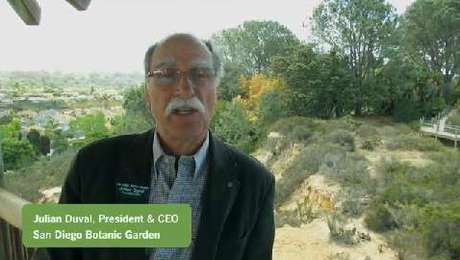Paul Redeker, director of horticulture, and Leslie Randall, plant curator, walk us through how they preserve natural plant habitats in Southern California. You will see which processes they use to eliminate invasive species and how they replace them with plants native to Southern California.
In order to preserve native plants, the invasive plants must first be eliminated. In addition, the indigenous plant material must be propagated so that native plants can be better established in the area.
Phase 1: Eliminating invasive plants
There are three invasive plants in this area:
- Tocalote, also known as Maltese star-thistle
- Sweet alyssum
- Black mustard
There are three methods to eliminate invasive plants: pulling, digging, and smothering.
It is best to try to remove these plants before they seed.
Large plants that cannot be dug out should be smothered. Cut down some of the height, and then get a dark, thick plastic sheet. Cover the plant, and weigh it down on the edges to keep the plastic sheet in place. After about a year, the plant should be dead.
Phase 2: Repopulating the area with native plants
Plants can be propagated by using cuttings, or with seeds.
When propagating plants at the San Diego Botanic Garden, keep the cuttings in a very well-draining cutting mix made up of peat moss, pearlite, small black lava, and fine vermiculite.
Make a fresh cut, strip off the lower leaves of the plant, dip it in rooting medium, make a hole, place the cutting into the hole, and then firm down the soil mix around the base of the plant cutting.
Don’t use plants that have flower buds starting.
Once a row of cuttings has been plated, water the cuttings at the base.
Label the plants. Use the scientific name of the plant, the area from which it was collected, and the collection date. Additionally, write down any treatment made to the cutting so that you know which methods are most successful.
In the meantime, cuttings can be transplanted into slightly larger plants after 6 to 8 weeks. Native plants can take some time before flushing out new roots.
Phase 3: Planting
Native cuttings should be ready to be planted within about six months to a year. Plant the cuttings in the fall, which is the best time to plant natives in Southern California.
Newly planted natives are flagged and given extra care and water in order to ensure they successfully get established.
Learn more about the San Diego Botanic Garden.

















Comments
Log in or create an account to post a comment.
Sign up Log in